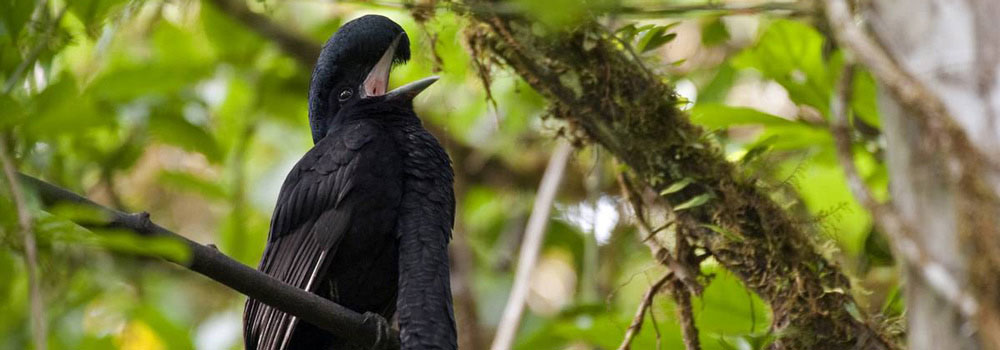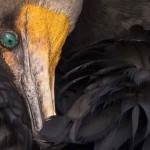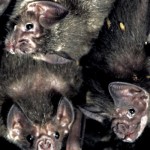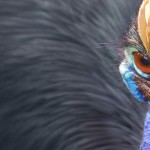A full-grown chapil palm tree can reach 110 feet tall, its corona of forty-foot fronds stretching skyward above the surrounding canopy. Competition for space and light can be intense among rain forest trees, and every mature, fruit-producing chapil that towers overhead had countless less-fortunate siblings that perished during the long journey from seed to adult. But what determines the winners and losers in that lottery? In the case of the chapil, part of the answer may lie in the social behavior of a curious endangered species known as the long-wattled umbrellabird.
The chapil (Oenocarpus bataua) is widely distributed—and widely consumed—throughout the South American tropics. Mammals such as tapirs and peccaries rely on the palm’s date-size purple-black fruits for food. Indigenous people use the fruits for medicine, food, and to make a thick, rich, nutty-tasting beverage. Birds that feast upon the chapil’s protein-rich fruits and seeds include some of the Amazon rain forest’s biggest and most brightly colored species, such as macaws and toucans.
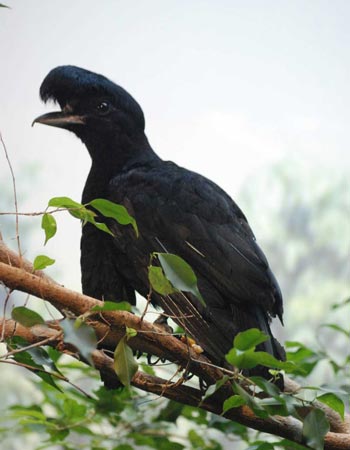 But on the other side of the Andes from the Amazon Basin the chapil palm serves the long-wattled umbrellabird—perhaps its most unusual avian patron—and benefits in return. There lies a distinct biogeographic zone called the Chocó, which extends down the mountains’ western flank to the coast in Colombia and Ecuador. That zone is characterized by rain forests even more humid than those of the Amazon, and harbors a distinctive and largely endemic flora and fauna. Thomas B. Smith, a biologist at the University of California, Los Angeles, and I have been studying long-wattled umbrellabirds and other endangered species in the Ecuadorian Chocó for several years. We initiated a conservation program that provides training, education, and sustainable alternatives to locals and Ecuadorian university biology students who assist in our research.
But on the other side of the Andes from the Amazon Basin the chapil palm serves the long-wattled umbrellabird—perhaps its most unusual avian patron—and benefits in return. There lies a distinct biogeographic zone called the Chocó, which extends down the mountains’ western flank to the coast in Colombia and Ecuador. That zone is characterized by rain forests even more humid than those of the Amazon, and harbors a distinctive and largely endemic flora and fauna. Thomas B. Smith, a biologist at the University of California, Los Angeles, and I have been studying long-wattled umbrellabirds and other endangered species in the Ecuadorian Chocó for several years. We initiated a conservation program that provides training, education, and sustainable alternatives to locals and Ecuadorian university biology students who assist in our research.
In our neck of the Chocó, the long-wattled umbrellabird (Cephalopterus penduliger) lays claim to the title of best-dressed dinner guest at fruit-bearing chapils. It is a large, charismatic, midnight-black bird, with a maximum wingspan of about two feet. Males have long crest feathers that, depending on their mood, they can retract like slicked-back pompadours (cool, relaxed) or expand to completely cover their heads (amorous, aroused). With his crest retracted, a male looks like Elvis on a bad hair day; with it expanded, he looks like Liberace on steroids. The crest accounts for the “umbrellabird” part of the name. Every male also has a thin, feather-covered flap of skin known as a wattle that hangs from his neck down past his tail. About eighteen inches long, the wattle looks rather like the ruffle on a tuxedo shirt, but functions more like a gold chain in the sexual lexicon of the species. Females are smaller than males and much more restrained in their appearance. Ecuadorians call the bird the pajaro toro, meaning bull-bird, because the male’s song resembles nothing so much as a lost bovine mooing in the forest. The calls travel more than half a mile, to attract females.
In spite of its outlandish appearance and trademark calls, not much is known about the long-wattled umbrellabird. It’s not an easy bird to see in the dark foliage; few birders and even fewer biologists have spotted it. It relies on pristine Chocó forests—habitat that is threatened by rampant deforestation. When the forest disappears, the umbrellabird is never far behind. Today it is in danger of extinction, its population having declined by at least 30 percent in the past decade—to less than 10,000 birds.
The loss of the umbrellabird would be a shame, of course, and particularly so for the chapil trees of the Chocó. My research shows that the chapils depend upon those flying fashionistas to disperse their seeds throughout the forest. At first glance, that service may seem trivial. But in fact, the importance to a rain forest tree of its seeds being carried to a favorable location cannot be overstated. Transportation away from the parent tree is key to a seed’s chances of survival to adulthood. Other birds and mammals eat chapil fruits, but in the Chocó nothing seems to eat more of them than long-wattled umbrellabirds, which flock to a fruiting tree and remain in the area for hours. When an umbrellabird feels peckish, it approaches one of the bundles of fruits that hang off the tree like horses’ tails, and hovers in front of it like some Daliesque hummingbird. Finally the umbrellabird plucks a plump morsel, swallows it whole, and returns to its perch to digest.
The fruit remains inside the bird’s belly for about an hour, we discovered (as I’ll explain), where its rich oils are stripped from its seed. When the seed has been cleaned of nutrients, the bird regurgitates it and spits it out onto the ground. Once the bird has eaten its fill of chapil fruits, it flies off, usually carrying a few not-yet-fully-processed seeds inside. Wherever the bird happens to be an hour or so after consumption, there the remaining seeds come out. A given seed may be dropped on rich soil, where it takes hold and begins the long and uncertain march toward adulthood. Or it may perish before germinating, if insects or other seed-destroying predators attack it, or if it lands in the middle of a cleared pasture and desiccates. Either way, the long-wattled umbrellabird plays a pivotal role in determining a seed’s fate.
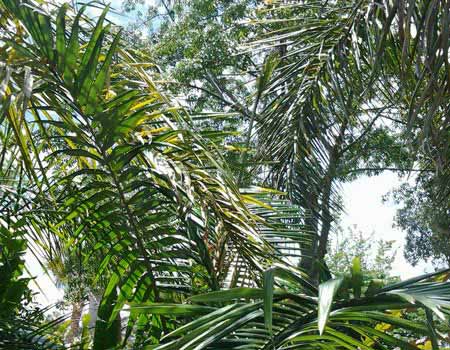 In addition to eating the fruits of chapils and other trees (along with the odd lizard, frog, or insect), male long-wattled umbrellabirds have one overriding preoccupation: sex. During the August-to-February mating season, groups of between five and fifteen males gather every morning and afternoon at special sites called leks, each of which typically covers about 4.5 acres. Most males stake out their own territories within a lek. Beginning in the predawn darkness, the males sit on their favored perches and bellow their moo calls out into the forest around them. As the day breaks, they begin to extend and retract their crests. They ruffle the feathers on their wattles and bob them up and down. They spread their wings out in a vulture-like pose and make a strange gurgling sound. They briskly beat their wings against their bodies, making a sound like the ears of a wet dog shaking its head dry. Sometimes they pull small branches off their perching trees and beat them against the limbs or trunk. They spend hours each morning and afternoon in such elaborate displays, often nearly falling off their branches from the exertion.
In addition to eating the fruits of chapils and other trees (along with the odd lizard, frog, or insect), male long-wattled umbrellabirds have one overriding preoccupation: sex. During the August-to-February mating season, groups of between five and fifteen males gather every morning and afternoon at special sites called leks, each of which typically covers about 4.5 acres. Most males stake out their own territories within a lek. Beginning in the predawn darkness, the males sit on their favored perches and bellow their moo calls out into the forest around them. As the day breaks, they begin to extend and retract their crests. They ruffle the feathers on their wattles and bob them up and down. They spread their wings out in a vulture-like pose and make a strange gurgling sound. They briskly beat their wings against their bodies, making a sound like the ears of a wet dog shaking its head dry. Sometimes they pull small branches off their perching trees and beat them against the limbs or trunk. They spend hours each morning and afternoon in such elaborate displays, often nearly falling off their branches from the exertion.
Singin’, dancin’, lookin’ fine . . . the males are, of course, trying to impress females! For their part, female umbrellabirds spend most of their time away from leks, and rarely intermingle with males. But each year, when it comes time for a female to reproduce, she visits the leks to find a sire for her offspring. Each male wants to convince every visiting female to copulate with him, and not with the guy down the hill. But females don’t rush headlong into romance. They shop around, extensively.
At first, a female may pass close to a lek without entering, listening to the different males sing. After a day or two of that, she may visit a male that sounds particularly good to her. She flies in silently and perches ten or fifteen yards away. When he notices her, he kicks his efforts into overdrive and begins an energetic sequence of singing, head bobbing, wattle ruffling, wing spreading, and whatever else may occur to him. She sits on her perch, apparently absorbed in preening her feathers, but really all eyes and ears, as he fires up his one-man show.
If she’s making her first visit, she will invariably fly off after a few minutes, as quickly and quietly as she came. She will definitely drop in on many males, and perhaps several different leks, before picking a mate. Sometimes she’ll return to the same lek for several consecutive days. Sooner or later, however, she settles on one male and begins to spend more time on his turf. Whenever she is near, the male feels compelled to ruffle, fluff, gurgle, and moo, pulling out all the stops.
Finally, the moment arrives, and she flies over and perches about a foot away from him. He slowly works his way toward her until he is by her side. He pauses. Crest flared and wattle ruffled to the max, he moos once or twice, maybe throwing in a gurgle for good measure. He then performs what my assistants refer to as “the deal-closer”—the umbrellabird equivalent of dimming the lights and putting on some Barry White. He vigorously sways his head away from the female and then back toward her, causing his wattle to swing up around her neck and come to rest on her back, like a feather boa. Her eyelids lower at such an intimate embrace, and he seizes the moment, hovering up behind her on the wing to consummate their brief union. Although the courtship takes several days, the sexual act lasts just seconds. Before you can say “long-wattled umbrellabird,” the male is back by her side and she jolts back to attention, preens a bit perhaps, and then flies away without a backward look.
And that is the extent of their relationship. The female is now on her own. She flies back to her home area in the forest, sometimes a few miles away and proceeds with the business of nesting. My team and I haven’t been able to document whether she builds her nest before mating or after, or how long she can hold sperm before fertilizing her eggs. (Some female birds can store sperm for months before they use it.) Sometime after copulating, however, the female lays a single egg. She alone then incubates the egg; feeds, broods, and protects the chick until it leaves the nest; and continues to care for it until it can fend for itself, a few months later.
The male’s life, conversely, remains centered on the lek. For several months of the year he spends most of his time there, leaving only to eat. He will never see the nest where his offspring is raised, and most likely wouldn’t know his own son or daughter if they met beak to beak. Such deadbeat-dad behavior may not provide a good example of responsible parenting by human standards, but it is part and parcel of the lek mating system as practiced by many bird species.
 My team and I hypothesized that the mating behavior of umbrellabirds might have important consequences for chapils and other plants whose fruits they disperse. Males, we thought, might bring a high proportion of the seeds they eat back to their lek sites. To test that idea, we trapped umbrellabirds of both sexes, attached lightweight, temporary radio transmitters to their tails, and released them unharmed. We then noted their locations over the course of several months as they traveled in search of food or displayed at their leks. A few of the birds we held in aviaries and fed chapil fruits, recording how long it took them to regurgitate the seeds—that’s how we arrived at the figure of one hour. Armed with those new data on movement patterns and seed-retention time, we were able to estimate where umbrellabirds of both sexes deposit the seeds they ingest.
My team and I hypothesized that the mating behavior of umbrellabirds might have important consequences for chapils and other plants whose fruits they disperse. Males, we thought, might bring a high proportion of the seeds they eat back to their lek sites. To test that idea, we trapped umbrellabirds of both sexes, attached lightweight, temporary radio transmitters to their tails, and released them unharmed. We then noted their locations over the course of several months as they traveled in search of food or displayed at their leks. A few of the birds we held in aviaries and fed chapil fruits, recording how long it took them to regurgitate the seeds—that’s how we arrived at the figure of one hour. Armed with those new data on movement patterns and seed-retention time, we were able to estimate where umbrellabirds of both sexes deposit the seeds they ingest.
Sure enough, we determined that males deposit roughly half their seeds in the lek sites. Females, on the other hand, distribute their seeds more evenly throughout the forest. In other words, the different reproductive behaviors of males and females translate into different dispersal patterns. To address how that affects chapils, we compared the rate of survival to the seedling stage for seeds deposited within and outside leks. We found no difference in the probability of survival. That came as a bit of a surprise: we had anticipated that high seedling density in the leks, and the resultant competition, would be a disadvantage. That it was not suggests that, for reasons we could not determine, the leks may be unusually favorable sites for chapil seedlings relative to the forest at large.
Working with Victoria L. Sork, a plant ecologist at the University of California, Los Angeles, my team and I are now using genetic markers to identify which adult trees the seeds arriving in umbrellabird leks came from. In addition to illuminating how umbrellabirds promote gene flow among chapil palms, that approach will tell us something about how forest fragmentation and deforestation affect seed dispersal patterns. The challenges are great, but between our research and our efforts to involve local residents in conservation work, we hope to preserve the age-old pact between a palm and its conspicuously plumed dispersal agent.

